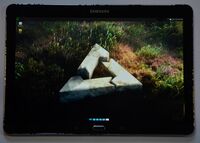Samsung Galaxy Note 10.1 2014 (samsung-n1awifi)
 n1awifi with the xfce GUI | |
| Manufacturer | Samsung |
|---|---|
| Name | Galaxy Note 10.1 (2014) |
| Codename | samsung-n1awifi |
| Released | 2013 |
| Type | tablet |
| Hardware | |
| Chipset | Samsung Exynos 5420 |
| CPU |
1.9 Ghz A15 Quad 1.3 Ghz A7 Quad |
| GPU | Mali-T628 MP6 |
| Display | 2560x1600 |
| Storage | 16/32 GB |
| Memory | 3 GB |
| Architecture | armv7 |
| Software | |
Original software The software and version the device was shipped with. |
Android 4.3 |
Extended version The most recent supported version from the manufacturer. |
Android 5.1.1 |
| postmarketOS | |
| Category | testing |
Mainline Instead of a Linux kernel fork, it is possible to run (Close to) Mainline. |
yes |
Unixbench score Unixbench Whetstone/Dhrystone score. See Unixbench. |
1940.5 |
| Device package |
|
| Kernel package |
|
Initial MR Initial merge request. |
pmaports!2135 |
Flashing Whether it is possible to flash the device with pmbootstrap flasher. |
Works
|
|---|---|
USB Networking After connecting the device with USB to your PC, you can connect to it via telnet (initramfs) or SSH (booted system). |
Works
|
Internal storage eMMC, SD cards, UFS... |
Works
|
SD card Also includes other external storage cards. |
Works
|
Battery Whether charging and battery level reporting work. |
Works
|
Screen Whether the display works; ideally with sleep mode and brightness control. |
Works
|
Touchscreen |
Works
|
Stylus |
Works
|
| Multimedia | |
3D Acceleration |
Partial
|
Audio Audio playback, microphone, headset and buttons. |
Broken
|
Camera |
Broken
|
| Connectivity | |
WiFi |
Works
|
Bluetooth |
Partial
|
GPS |
Broken
|
| Miscellaneous | |
FDE Full disk encryption and unlocking with unl0kr. |
Works
|
USB OTG USB On-The-Go or USB-C Role switching. |
Broken
|
HDMI/DP Video and audio output with HDMI or DisplayPort. |
Broken
|
| Sensors | |
Accelerometer Handles automatic screen rotation in many interfaces. |
Works
|
Magnetometer Sensor to measure the Earth's magnetism |
Works
|
Ambient Light Measures the light level; used for automatic screen dimming in many interfaces. |
Works
|
Proximity |
Works
|
Hall Effect Measures magnetic fields; usually used as a flip cover sensor |
Works
|
| The LTE variant with Qualcomm Snapdragon is a distinct device, even though it has almost the same name. See the device page for specific information and port status. |
Contributors
- Michaszek8
- Eisenbahnfan2015
Maintainer(s)
- Eisenbahnfan2015
Users owning this device
- Doppioandante
- Eisenbahnfan2015 (Notes: Unlocked - Used for mainlining)
- LedBass
- Nopraz (Notes: Currently running PostmarketOS)
- VertexIsHere (Notes: Running postmarketOS (heimdall can't detect the device, looks like i stuck))
Flashing
Flashing can be done through Heimdall. Alternatively, one can use TWRP.
Flashing with heimdall
Enter flash mode by keeping + pressed.
Then use pmbootstrap flasher flash_kernel, reboot once again in flash mode and use pmbootstrap flasher flash_rootfs.
You can do the full flashing at once with the following commands (supposing heimdall is in your PATH):
$ pmbootstrap export
$ heimdall flash --BOOT /tmp/postmarketOS-export/boot.img --SYSTEM /tmp/postmarketOS-export/samsung-n1awifi.img
Flashing with TWRP
After having installed TWRP, press and hold + . Press when prompted.
To create a TWRP flashable zip:
$ pmbootstrap install --android-recovery-zip
$ pmbootstrap export
Run adb push /tmp/postmarketOS-export/pmos-samsung-n1awifi.zip to copy zip to the device, reboot to TWRP and install the zip and then reboot to system. You can also use adb sideload as instructed in recovery zip installation.
On 16GB devices it is highly recommended to install system on /data partition due to lack of storage:
$ pmbootstrap install --android-recovery-zip --recovery-install-partition=data
$ pmbootstrap export
Issues
- Lockscreen doesn't work properly on Gnome and Phosh (screen turns off, device seems to work, but it can't be waken up through hardware buttons or keyboard)
- Visual glitches in Plasma Mobile
- Wifi stops working after reboot
Tested desktop environments
Tested with android recovery installation to the data partition. "Working" boots to the desktop, "Not working" does not.
Working
GNOME, Phosh, Xfce4, Plasma Mobile
Not working
GNOME Mobile, Lomiri (Failed to flash using TWRP, to test)
Additional info
Unixbench results
========================================================================
BYTE UNIX Benchmarks (Version 6.0.0)
System: samsung-n1awifi: Linux
OS: Linux -- 6.17.7-postmarketos-exynos5 -- #141 SMP PREEMPT Mon Nov 10 13:28:43 UTC 2025
Machine: armv7l (unknown)
Language: en_US.utf8 (charmap="UTF-8", collate=)
CPU 0: ARMv7 Processor rev 3 (v7l) (54.0 bogomips)
CPU 1: ARMv7 Processor rev 3 (v7l) (54.0 bogomips)
CPU 2: ARMv7 Processor rev 3 (v7l) (54.0 bogomips)
CPU 3: ARMv7 Processor rev 3 (v7l) (54.0 bogomips)
16:58:00 up 12 min, 0 users, load average: 1.48, 1.42, 0.91; runlevel
------------------------------------------------------------------------
Benchmark Run: Mon Nov 10 2025 16:58:00 - 17:03:03
4 CPUs in system; running 1 parallel copy of tests
Dhrystone 2 using register variables 7539961.9 lps (10.0 s, 7 samples)
Double-Precision Whetstone 2554.0 MWIPS (9.9 s, 7 samples)
System Benchmarks Partial Index BASELINE RESULT INDEX
Dhrystone 2 using register variables 116700.0 7539961.9 646.1
Double-Precision Whetstone 55.0 2554.0 464.4
========
System Benchmarks Index Score (Partial Only) 547.7
------------------------------------------------------------------------
Benchmark Run: Mon Nov 10 2025 17:03:03 - 17:07:56
4 CPUs in system; running 4 parallel copies of tests
Dhrystone 2 using register variables 25453923.5 lps (10.0 s, 7 samples)
Double-Precision Whetstone 9495.7 MWIPS (10.3 s, 7 samples)
System Benchmarks Partial Index BASELINE RESULT INDEX
Dhrystone 2 using register variables 116700.0 25453923.5 2181.1
Double-Precision Whetstone 55.0 9495.7 1726.5
========
System Benchmarks Index Score (Partial Only) 1940.5